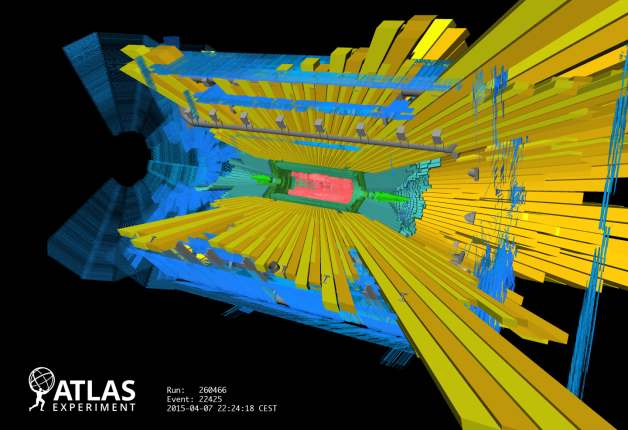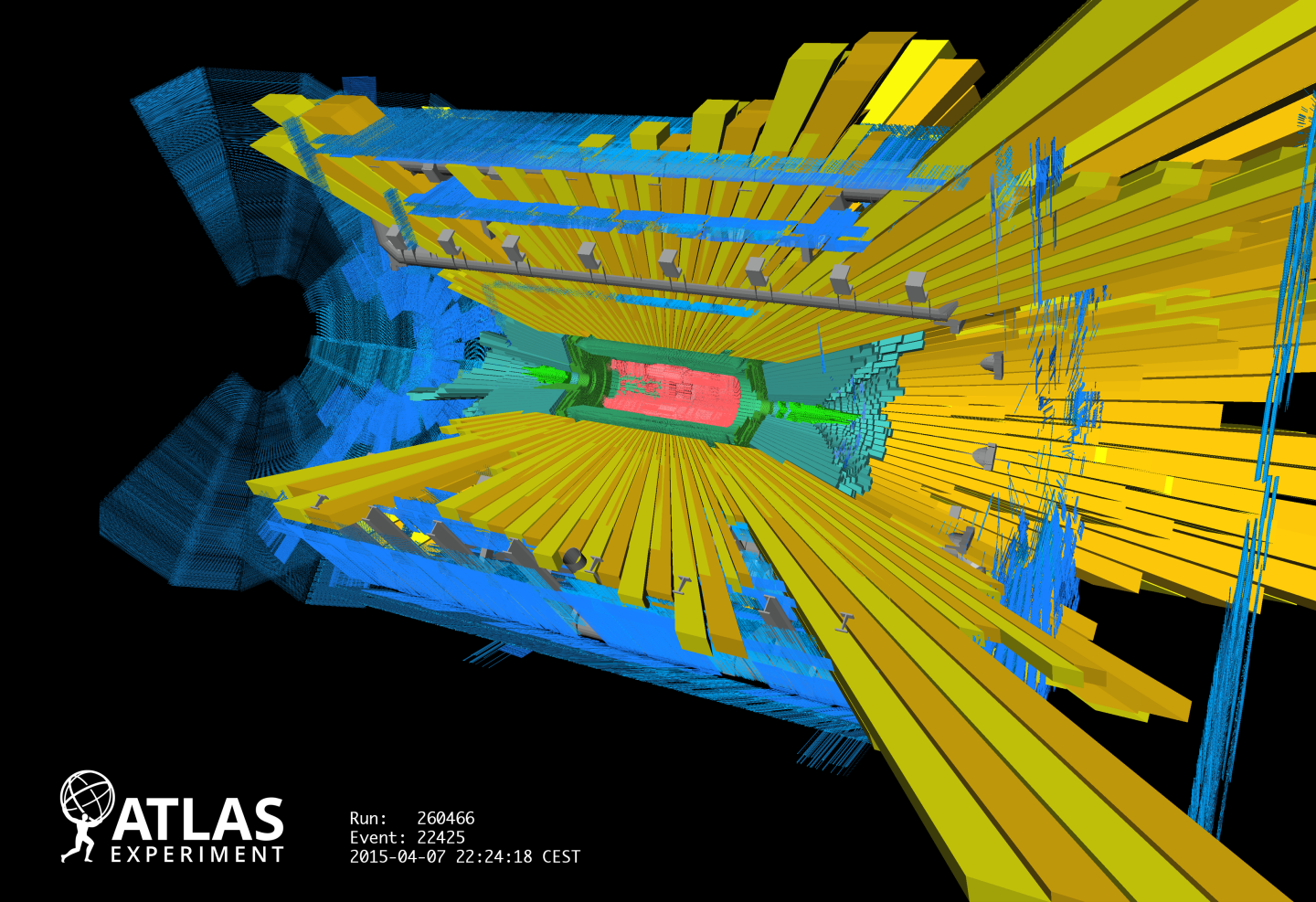
Event display of one of the collimator “splash” event seen by the ATLAS experiment in LHC Run-2 , on Tuesday April the 7th : event 22425, run 260466. The collimator position is 140m in front of the ATLAS interaction point. The spray of particles enters ATLAS from the left hand side of the picture. The length of the yellow bars indicates the energy deposited in the ATLAS calorimeter. Credit: CERN
Today scientists at the Large Hadron Collider at CERN, the European research facility, started recording data from the highest-energy particle collisions ever achieved on Earth. This new proton collision data, the first recorded since 2012, will enable an international collaboration of researchers that includes more than 1,700 U.S. physicists to study the Higgs boson, search for dark matter and develop a more complete understanding of the laws of nature.
“Together with collaborators from around the world, scientists from roughly a hundred U.S. universities and laboratories are exploring a previously unreachable realm of nature,” said James Siegrist, the U.S. Department of Energy’s associate director of science for high-energy physics. “We are very excited to be part of the international community that is pushing the boundaries of our knowledge of the universe.”
The Large Hadron Collider, the world’s largest and most powerful particle accelerator, reproduces conditions similar to those that existed immediately after the Big Bang. In 2012, during the LHC’s first run, scientists discovered the Higgs boson—a fundamental particle that helps explain why certain elementary particles have mass. U.S. scientists represent about 20 percent and 30 percent, respectively, of the ATLAS and CMS collaborations, the two international teams that co-discovered the Higgs boson. Hundreds of U.S. scientists played vital roles in the Higgs discovery and will continue to study its remarkable properties.
Scientists will use this new LHC data to pin down properties of the Higgs boson and search for new physics and phenomena such as dark matter particles—an invisible form of matter that makes up 25 percent of the entire mass and energy of the universe. Physicists will also endeavor to answer questions like: Why is there more matter than antimatter? Why is the Higgs boson so light? Are there additional types of Higgs particles? What did matter look like immediately after the Big Bang?
“NSF-funded researchers at ATLAS, CMS and LHCb are investigating some of nature’s most fundamental properties at collision energies never before explored. The potential for transformative discoveries is profound,” said Denise Caldwell, NSF’s division director for physics. “We eagerly look forward to LHC operation at almost twice the energy of any other particle accelerator on Earth.”
The LHC was turned off in early 2013 and engineers spent two years preparing the machine to collide particles at a much higher energy and intensity. During the shutdown U.S. scientists and their international collaborators installed several new components in the four LHC detectors. These components, together with other upgrades, will allow physicists to record more information about the particles produced during the high-energy collisions.
These upgrades included a new detector in the heart of the ATLAS experiment, several new muon detectors on the outer shell of the CMS experiment, a new calorimeter inside the ALICE experiment, and an innovative new data sorting system for the LHCb experiment. U.S. scientists played vital roles in the design and instrumentation of these new systems and will operate several of the detector components throughout the next three years of data collection.
Once collected at CERN in Geneva, Switzerland, the new LHC data travels the globe. New fiber optic cables recently installed by the U.S. Department of Energy bring the data to computers and data centers at eighteen U.S. institutions, which provide 35 percent of the worldwide computing power for the CMS experiment and 23 percent for the ATLAS experiment.
The upgraded LHC will also generate data at a much faster rate. Scientists predict they will match the amount of data generated throughout the collider’s first three-year run within the next five months, eventually accumulating 10 times more data by the end of 2017. These collisions will also produce Higgs bosons 25 percent faster and will increase the chances of seeing other theoretical particles, such as those predicted for supersymmetry, by over 40 percent.
“The first 3-year run of the LHC, which culminated with major discovery in July 2012, was only the start of our journey. It is time for new physics!” said CERN Director General Rolf Heuer. “We have seen first data beginning to flow. Let’s see what they will reveal to us about how our universe works.”
Media contacts:
- Sarah Charley, US LHC communications coordinator, [email protected], 630-338-3034 (cell)
- Rick Borchelt, director, Office of Communications and Public Affairs, U.S. Department of Energy, [email protected], 202-586-4477
- Ivy F. Kupec, National Science Foundation, [email protected], 703-292-8796
- Andre Salles, Fermilab Office of Communication, [email protected], 630-840-3351
Berkeley Lab media contacts:
- Ian Hinchliffe, head of Berkeley Lab participation in ATLAS, [email protected], 510-486-4487
- Beate Heinemann, deputy spokesperson for ATLAS, Berkeley Lab staff scientist, and professor of physics at UC Berkeley,[email protected], 510-486-7538
- Peter Jacobs, head of Berkeley Lab participation in ALICE, [email protected], 510-486-5413
- Natalie Roe, Director of Berkeley Lab’s Physics Division, [email protected], 510-486-6380
More information on Berkeley Lab’s recent involvement in the LHC:
Beyond the Higgs Boson: A Detector Add-on Helps Scientists Look Deeper
A Closer Look at the Perfect Fluid
Physicists Replicate the Big Bang (video)
What to Expect Next from the World’s Largest Particle Accelerator
###
Lawrence Berkeley National Laboratory addresses the world’s most urgent scientific challenges by advancing sustainable energy, protecting human health, creating new materials, and revealing the origin and fate of the universe. Founded in 1931, Berkeley Lab’s scientific expertise has been recognized with 13 Nobel prizes. The University of California manages Berkeley Lab for the U.S. Department of Energy’s Office of Science. For more, visit www.lbl.gov.
CERN, the European Organization for Nuclear Research, is the world’s leading laboratory for particle physics. It has its headquarters in Geneva. At present, its Member States are Austria, Belgium, Bulgaria, the Czech Republic, Denmark, Finland, France, Germany, Greece, Hungary, Israel, Italy, the Netherlands, Norway, Poland, Portugal, Slovakia, Spain, Sweden, Switzerland and the United Kingdom. Romania is a Candidate for Accession. Serbia is an Associate Member in the pre-stage to Membership. India, Japan, the Russian Federation, the United States of America, Turkey, the European Union, JINR and UNESCO have Observer Status.
Fermilab is America’s premier national laboratory for particle physics and accelerator research. A U.S. Department of Energy Office of Science laboratory, Fermilab is located near Chicago, Illinois, and operated under contract by the Fermi Research Alliance, LLC. Visit Fermilab’s website at www.fnal.gov and follow us on Twitter at @Fermilab.
The DOE Office of Science is the single largest supporter of basic research in the physical sciences in the United States and is working to address some of the most pressing challenges of our time. For more information, please visit science.energy.gov.
The National Science Foundation (NSF) is an independent federal agency that supports fundamental research and education across all fields of science and engineering. In fiscal year (FY) 2015, its budget is $7.3 billion. NSF funds reach all 50 states through grants to nearly 2,000 colleges, universities and other institutions. Each year, NSF receives about 48,000 competitive proposals for funding, and makes about 11,000 new funding awards. NSF also awards about $626 million in professional and service contracts yearly.
